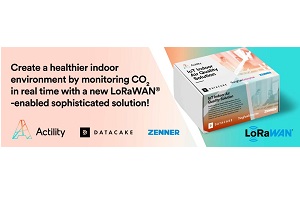Paris, France Actility, in joint work with Zenner, a manufacturer of measuring devices and sensors from Germany and DataCake, a low-code IoT platform provider, now offer a new IOT indoor air quality solution focused on monitoring the environmental characteristics inside buildings that may affect human health, comfort, or work performance sustained.
The solution is using LoRaWAN connectivity and includes CO2 monitoring sensor from Zenner, LoRaWAN network server and management platform from Actility – ThingPark Enterpise, and the application from Datacake. The solution is extremely simple to set up and allows monitoring in real-time the concentration of CO2 to create a safer and healthier indoor ambient condition, protect employees, workers or students, and meet air quality regulations levels. It can be used in any indoor space, including classrooms, offices, meeting rooms, shops, industrial facilities, and public buildings, among others.
This IOT indoor air quality solution is now available on ThingPark Market, Actility’s IoT solutions marketplace!
Optimisation of air quality is crucial for healthy and productive working conditions
Covid-19 has dramatically changed our lives, we have changed our lifestyles, spending more time in our homes being forced to cope with medical emergencies, therefore it has become increasingly important to monitor indoor air quality (IAQ).
The concentration of CO2 is an important indicator of air quality. The higher the CO2 value in a building, the less comfortable it is for the people who live there. CO2 concentrations rise rapidly in poorly ventilated rooms.
The EU Royal Decree of 2 May 2019 well-being code at work on indoor air quality establishes that the employer must take the necessary technical and/or organisational measures to ensure that CO2 concentrations in the workplace are less than 900 ppm.
According to scientific research, improving IAQ is as effective as vaccinating 50-60% of the population in reducing aerosol transmission. Carbon dioxide, volatile organic compounds (VOCs), particulate matter (PM), humidity, and temperature monitoring necessitate the installation of sensors in facilities that do not typically rely on pre-existing wiring for this purpose. These installations are facilitated by wireless IoT networks such as LoRaWAN. It is the ideal technology network to meet these requirements.
LoRaWAN (long range wide area network) is an open standard connectivity technology that has proven to be a market provider for smart applications, delivering solutions that are easy to scale, optimise operational costs, and reduce utility waste. LoRaWAN enables the use of its extremely long-range and low-power capabilities to cover thousands of kilometers at a low cost, particularly in remote and difficult-to-reach areas, and to install devices that provide data in real time while lasting for years on a single battery charge.
Key solution features:
- Sensor design: clean and modern design, which makes it discrete in both business and home environments.
- Ease of use: A wireless and battery-based sensor provides the conditions for its users to perform the tasks safely, effectively, and efficiently while enjoying the experience.
- Adaptability: Scalable and tailor-made solution: An adapted kit to any indoor industrial environment such as warehouses storage, retail, offices, and much more.
- Low-power and low-cost: LoRaWAN long-range technology allows easy installation and the ability to monitor sensors in a very large area with low infrastructure cost.
Data-driven management: Efficiency gain: stand at the threshold of our shared indoor spaces, and answer new questions raised: “What is the air quality?” or “Do we need to open a window?”
A sophisticated designed Zenner Sensor
A compact indoor EU868 LoRaWAN radio sensor for measuring the CO2 content of indoor air. With the integrated display and the color-changing LED display, the sensor always provides real-time information about the current CO2 value, the battery level, and the status of the connection.
An intuitive and // application by Datacake
Datacake is a multi-purpose, low-code IoT platform that requires no programming skills and minimal time to create custom IoT applications that can be brought into a white-label IoT solution at the push of a button. With the Datacake platform, you can realise your Industrial IoT use cases, such as condition monitoring, data logging, real-time dashboards, and data analytics.
It provides you with templates for the most popular devices.
- Device templates
- Integrations for LoRaWAN network server
- Payload decoders and downlinks
With the trial kit, you will get a 3 x Months subscription to Datacake application up to 2 devices.

IoT connectivity platform by Actility
Dependable connectivity infrastructure with a proficient UX to easily build a LoRaWAN network, cloud-based or on premises, using pre-integrated high-end base stations & an advanced Actility network server with dashboards providing key operational insights on the network & alarm management.
With the Trial Kit, you will get 3 x months subscription to ThingPark Enterprise SaaS service.
1 x Browan Pico NEXT LTE gateway (included) pre-installed and configured or OPTION: 1 x Milesight UG65 semi-industrial LoRaWAN gateway
The Pico Next Gateway is a LoRa gateway with GPS, using numerous ways of connection: ethernet, LTE, and Wi-Fi. Depending upon the SKU, some functions might not be available. Pico Next is specifically designed for wide-area IoT applications. Applications include, but are not limited to, home security, automatic meter reading, monitoring fault-indicators, and monitoring streetlights. This gateway is very suitable for small businesses or restricted area uses like parking lots, exhibition centres, and campuses.
UG65 is a robust 8-channel indoor LoRaWAN gateway. Adopting SX1302 LoRa chip and high-performance quad-core CPU, UG65 supports connection with more than 2000 nodes.UG65 has line of sight up to 15 km and can cover about 2km in urbanised environment, which is ideally suited to smart office, smart building and many other indoor
Comment on this article below or via Twitter: @IoTNow_OR @jcIoTnow







